Audio available at the end of this post.
The notion of an ‘edge’ has been on my mind a lot lately. I also tweeted about it, which got some very interesting responses:
In particular, Marios Stamatoudis gave a very detailed response, bringing out the Greek philosopher in him. Worth reading if you missed it!
But what is an edge?
When asking that question, I tend to see one of the following:
A short, simple answer — e.g. ‘a competitive advantage’.
A component of an edge — e.g. ‘composure’ or ‘patience’.
What an edge is not — most notably, that a setup ≠ an edge.
In other words, the answer is either very specific, or so broad that it reads like a dictionary definition.
What people don’t tend to do is delve into the core principles behind an edge — in trading and elsewhere.
Understandably so. This isn’t easy to do.
I’m having a go at this today. And where you think I missed the mark, or left out a crucial component, please leave a comment below or shoot me a message!
Core principles behind an edge
Several core principles lurk behind an edge, within and outside of trading. I’ve picked out three to discuss today:
Leveraging your strengths
Paying attention to detail
Execution and patience
1. Leveraging your strengths
By definition, an edge means having something valuable that others lack, like specific:
Skills
Traits
Knowledge
Experience
In sports, that might be height, speed, strength or agility. Or maybe you’re okay at all those things, but you’re an exceptional tactician. Or perhaps you understand details and nuances about the game that no one else does.
Any of those things can be an edge.
But not in and of itself.
The real magic lies in knowing how to leverage your strengths, whatever their nature.
If you can control the game to take advantage of your strengths, and avoid your weaknesses, that’s when you start to develop a meaningful competitive advantage.
Example: pummelling
Josh Waitzkin gave a nice example of this in The Art of Learning:
“If you ever hear martial artists talking about a ‘pummeling war’ they […] mean that two people […] are fighting for underhooks.
“It turns out that pummeling would be a huge component of my tournament strategy. […] Since [my shoulder injury], the shoulder has been my Achilles heel. […] After weeks of pain, I decided to concede the pummeling war and take double outside position in training to avoid damaging the shoulder any further.
“While I initially felt at a disadvantage giving Dan [Caulfield] the underhooks, over time I became increasingly comfortable. I came up with some subtle ways to crimp his leverage and I found that I could make the angles work for me. [In time,] I felt completely dominant from the outside position.
“My weakness had blossomed into a weapon that would prove critical for me in Taiwan.
“You see, the Taiwanese are lightning-quick with their pummeling and I made the decision early in the tournament not to fight it—don’t play their game. By giving them that first position they were so used to fighting for, I mitigated a large part of their training: the pummeling war.
“Then we would do battle in the setup I had become expert in, and that they hadn’t studied as deeply.
“This happens all the time in chess at the highest levels; top players discover hidden resources in opening positions that had been considered theoretically weak. They become masters of a forgotten or undiscovered battleground and then guide opponents into the briar patch.”
I find this a beautiful example of an edge.
It’s not simply identifying your strength or, for that matter, your weakness. Edge lies in knowing things others do not. Or doing something better than anyone else.
Find the roads less travelled. Then, direct the play towards those roads.
A strength is only an edge if it reflects a skill or knowledge that actually matters.
Curiosity
Even if you have aptitude, it takes hard work — at least 10,000 hours of the right (and therefore difficult) type of training — to achieve mastery.
That’s a lot of hours. Unless you have superhuman discipline, this requires genuine passion, which in turn is sparked by curiosity.
Curiosity will always beat competence. It’s what drives hard work and inspires creativity. If you follow your curiosity, you improve your odds of playing to your strengths and getting exceptional results.
Genuine curiosity and passion enable you to play the long game. (More on that later.)
Your edge must suit your personality
Qullamaggie said on his website:
“I learned from a lot of people; I was in many different chatrooms and trading communities, went to seminars, read a lot of books, articles, etc. Picked up bits and pieces and developed my own thing that fits my own personality.”
That final point is key.
We’re all unique — by our environment, by our experiences and by our DNA.
Consequently, we each have our likes and dislikes. Things that are important to us, and things that aren’t. Things we’re bad at, things we’re decent at, and things we can excel at.
This blend makes each of us unique. And each of us has a natural, inner voice — often developed from a very young age — that must be cherished and nurtured.
Importantly, you can’t be doing activities that require you to quell your inner voice, then expect to perform at your best.
(Which is why your performance will probably improve when normal momentum trading practices — such as buying high — stop feeling counterintuitive to you.)
Avoiding internal conflict while you learn
So, how do you overcome your weaknesses and grow?
A fundamental part of the learning process is being unhindered by internal conflicts. Josh describes the following as the right balance:
“We have to release our current ideas to soak in new material, but not so much that we lose touch with our unique natural talents.”
Also:
“I believe that one of the most critical factors in the transition to becoming a conscious high performer is the degree to which your relationship to your pursuit stays in harmony with your unique disposition.
“There will inevitably be times when we need to try new ideas, release our current knowledge to take in new information—but it is critical to integrate this new information in a manner that does not violate who we are.
“By taking away our natural voice, we leave ourselves without a center of gravity to balance us as we navigate the countless obstacles along our way.”
From a practical point of view, how can we achieve this?
In my view, this comes down to two things:
Stretching without snapping.
Leveraging the human mind’s tendency to define one thing in relation to another.
Stretching without snapping
This concept applies to both physical and mental activities.
Physically, if you don’t push yourself, you’re not going to gain muscle — because you’re not giving your body a reason to change.
Mentally, you have to ‘agitate’ your brain. This is why people say you have to get uncomfortable to grow. If you’re comfortable doing something, you’re not giving your brain a reason to change. (Note the similarity with physical growth!)
Cal Newport uses the phrase “deliberate practice” for this. He also discussed a study that found that elite violin players, compared to average players:
Spend almost three times as long doing deliberate practice; and
Consolidated their practice into two well-defined sessions a day, rather than spreading it out during the day.
That second point meant the elite players were, generally in their lives, more relaxed, too! A lesson for us all there, I think. Deliberate practice is hard, but time-efficient.
And remember not to push too hard. Snapping — whether through injury or burnout — will get you nowhere.
Leveraging our tendency to define one thing in relation to another
This is something Josh points out very well:
“The human mind defines things in relation to one another—without light the notion of darkness would be unintelligible.
“Along the same lines, I have found that if we feed the unconscious, it will discover connections between what may appear to be disparate realities.”
Given my experiences with photophobia, I can really relate to this.
But to bring it back to more pleasant things to learn, one of Josh’s examples includes studying “the greatest attacking chess games ever played” to “inevitably gain a deep appreciation for defensive nuance”.
In my own case as a writer, if I hadn’t started tweeting and writing stacks, I wouldn’t have gained an appreciation for how much better the reading experience is if you:
Vary paragraph lengths, with no long paragraphs;
Use text formatting to your advantage; and
Have lists either expand or compress.
When I go back to writing books again, I’m definitely going to apply those lessons. No more paragraphs that take up a third of the page!
What about trading?
The broader lessons Josh pointed out also apply to trading.
Only this week, Kyle tweeted that just because a strategy makes sense to you, doesn’t mean you can execute it well. You must track your behaviour and emotions, so you can form a system around them. As Kyle said:
“It’s a lot easier to bend a system to favor your emotions than it is to bend your emotions to favor a system.”
Tom Dante provided some really hard-hitting examples of “the edge is in you” in this tweet, which is a great read. Tom is brilliant at conveying lessons through storytelling.
To paraphrase him, in his earlier days, he believed the way to learn to trade well was to copy what a great trader is doing. Sounds reasonable enough, right?
Except he then watched a brilliant trader put in a big order, get filled, and immediately get out — at the same price.
Tom’s response: “I was dumbfounded. Price literally hadn’t moved.”
So, why did this trader get in and out at the same price? Because he could tell by the way his order filled that the price was going to move lower. In Tom’s words:
“This ledge had made millions but I realised that kind of trading just wasn’t me. I wasn’t able to process that kind of information from the T&S [time & sales] and react quick enough.
“Could I have learnt it? Possibly. But I am patient and methodical and those traits didn’t sit well with that style of trading.”
In similar vein, not everyone can:
Hold through pullbacks;
Tolerate low strike rates; or
Handle lots of decision-making.
So, figure out what works for you. Some strategies inherently have a better expectancy than others, but that doesn’t mean everyone can capitalise on that expectancy.
As Tom said:
“If the edge was fully in the strategy, everyone learning it would be banking.
“This is never the case.
“The edge is in you as the trader. It always has been and always will be.”
He’s also written this really nice thread about his edge.
2. Paying attention to detail
Once again, your edge lies in knowing things others do not. In your ability to pick up things that other people miss. As they say: the devil is in the details.
I’ve previously written about the good and bad of free education.
The good is that, well, it’s free.
The bad is that the barrier to entry is non-existent. So, with that, you’d better be doing more with those resources than anyone else. A big Qullamaggie lesson is that you must do the things other people aren’t prepared to do to be successful.
A significant part of that is actually rather simple (but not easy): do a deep dive. Build a database with thousands of charts, and study them. Every trader who achieved meaningful success spent countless hours poring over charts.
When you do this, you start noticing the details. The context of your setup. Stuff like:
What theme does the name belong to?
Situational awareness — when does and doesn’t the setup work?
The history of the stock: what types of moves has it made in the past? What’s the character of the stock?
With a continuation setup, what was the magnitude of the initial move? And was it triggered by a catalyst (EP)?
Without this type of self-developed understanding, you won’t have conviction. And you won’t select stocks well — a key determinant of your gains.
Yet so many traders — and people in general — believe that some shortcut exists, if only they can find it.
A writing analogy
Cal Newport has a good way of putting this: the stories people tell themselves are usually “challenging but tractable”.
A writing example is a belief that you can become a better writer by spending a lot of time reading, or thinking about writing. When in reality, though both may help a bit, there’s no shortcut to doing the actual work: to write more. At the moment, I write around 100,000 words a month.
(At some point, I want to cut back on that to spend more time on the ‘thinking’ side of things, but right now, I’m just trying to get good at writing itself. That’s my current training — the kind most writers won’t do, even though it’s known to work. And despite it being pretty darn fun, if I say so myself!)
The ‘holy grail’ in trading
In trading, people look for the ‘holy grail’.
But if there is such a thing in trading, it’s the simple stuff that’s hard to do: studying, journal analysis, relentless problem-solving, etc. And it’s sacrifice: focusing on just one setup, and really learning that setup inside out. Doing these things enables you to be good at stock picking and execution.
I love this eloquent explanation by JUNO:
“A setup in itself isn’t an edge. Something that can be taught over YouTube in an hour can never be an edge.
“The discretion to allocate our limited resources into one breakout setup over [another] based on what we’ve identified as commonalities in today’s best opportunities is an edge.”
Qullamaggie stream notes
JUNO’s point about YouTube brings me back to free resources. Anyone with an internet connection can watch, say, Qullamaggie’s streams. So, if everyone is aware of them, superficially watching them isn’t an edge.
When it comes to the streams, I think that the edge lies in paying close attention to what Kristjan does, not what he says. It’s making that effort to try and understand why he made the decisions he did. Why he favours one setup over another. And so on.
This is why I went into such detail in my stream notes. They helped my own studies. Simply sticking together screenshots and a bunch of quotes has limited benefit. Particularly when AI can do that as well as a human can (or soon will be able to).
3. Execution and patience
Execution brings us back to the opening tweet, quoting last week’s stack:
“On its own, a setup can never be an edge. The edge lies in its execution.”
I firmly believe that the best way to improve your execution is to analyse your journal. There’s nothing like your own hard numbers to give you the conviction and discipline to instigate lasting behavioural change.
Consistency
Execution is critical to your edge. So, your ability to be consistent during performance time — i.e. when you’re trading — is vital. Once again, trading is like a sport.
Getting more concrete, I think that means you need two things:
A ‘trigger’ to get yourself ‘in the zone’ when needed. I think the ‘soft zone’ that Josh talks about is very useful here. He also talks about ‘building your trigger’.
A system that monitors your performance and can quickly alert you that you’re off your game. A ‘detection system’, if you like, so you can quickly identify and fix issues. For this, I think journaling is the answer, both mechanical and mental.
Patience
I also want to draw your attention to patience, which I believe vital for developing an edge in any field.
Nobody ever created anything great on a short time scale. Excellence doesn’t happen overnight — even the most talented among us needed at least 10,000 hours of practice to reach the top of their field.
The simple ability to recognise this and act accordingly is, in my opinion, a vital ingredient to someone’s edge.
In trading, patience is doubly important. You’re playing the long-term game in terms of building the skill to start with. Then, once you have the skill, you’re waiting for the right market environment to come along.
Those “big moves” are what Anthony Shi (Dolan V. Kent) calls ‘swing cycles’. But they don’t come around very often. So, patience is key.
Doing anything great requires you to play long-term games.
Trading and, in particular, investing are perhaps the longest-term games of all.
Think in decades, not years.
Recap and self-reflection
Certain elements of a trading edge are specific, or more specific, to trading. Things like risk management, situational awareness, position sizing, etc.
But all the top competitors in any field require an edge: a competitive advantage. In other words, you must have or know something of value that others do not.
So, what characteristics must that ‘something’ have?
I’ve settled on three, which apply across different disciplines, trading included:
Leveraging your strengths
Paying attention to detail
Execution and patience
Out of the three, point #1 gave me most food for thought, as reflected by the length of that section in this write-up.
It also got me to reflect on myself as a writer: what’s my natural strength?
According to a reader, it’s my “ability to weave together [my] own thoughts with information from multiple sources”. That aligns with what I wrote here.
I like to connect ideas from different people. Particularly when those people have very different skill sets and, preferably, come from different fields — because that’s how you uncover the most fundamental principles. Which is what I tried to do in this stack.
My interest in what connects different fields stems from my own desire to become good at both writing and trading. At the same time, I recognise that, if it really came down to it, I’d choose writing. It’s the thing I love most.
But it’s no use simply being good at stringing together words. The words need to have substance, which requires knowledge. That’s not unlike translation — the best translators (and interpreters) aren’t just good linguists, but also very knowledgeable in a field of their choosing.
The field that endlessly intrigues me is trading. Particularly retail trading.
You can’t make it as a trader unless you’re exceptionally good at what you do. You literally will be forced out of the arena if you aren’t in the top 5%.
This reality attracts, to my mind, very inspiring people. Several of whom have had a major impact on my life, even though I’ve never met them in person.
This developed my fascination for exploring how to achieve excellence. In any field.
Through that journey — partly documented on this Substack — I’ve developed a new appreciation for the effort required to create something good, and to relentlessly improve. As well as a new appreciation for compounding: consistent efforts, no matter how small, are all it takes to exponentially improve your performance.
I’m also increasingly learning how different disciplines are far less different than I previously thought. More specifically, the things one has to do to reach the top aren’t that different from one field to the next.
(This intrigues me so much, I may just start a new newsletter, or at least a series within this one, called something like ‘Studying Success’ or ‘Pursuing Excellence’. Again, follow your curiosity! And yes, the name needs work.)
Whatever my path, I’ll continue to document the journey and lessons I’ve learnt on my Substack and 𝕏/Twitter.
I hope you’ll join me. If you aren’t already subscribed, please do, so you’ll get new posts straight to your inbox. It’s free!
Listen to this stack
More content like this
The Trading Resource Hub’s full archive is here.
Supporting my work
This Substack will never be paywalled. I don’t even want to accept voluntary payments for future unknown work.
But if you got this far, chances are that you find my writing valuable.
If so, I’d love it if you bought me a coffee:
All other support is appreciated too :) Sharing, liking and commenting all help spread the word!




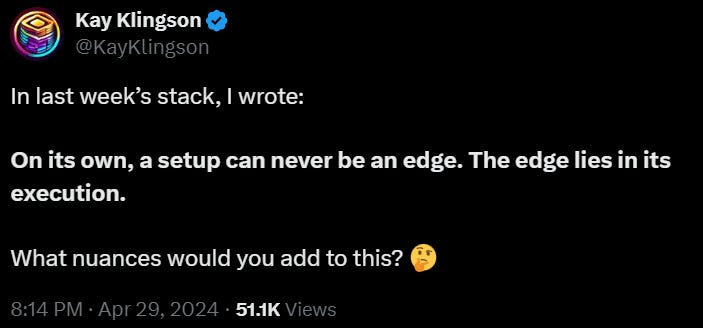
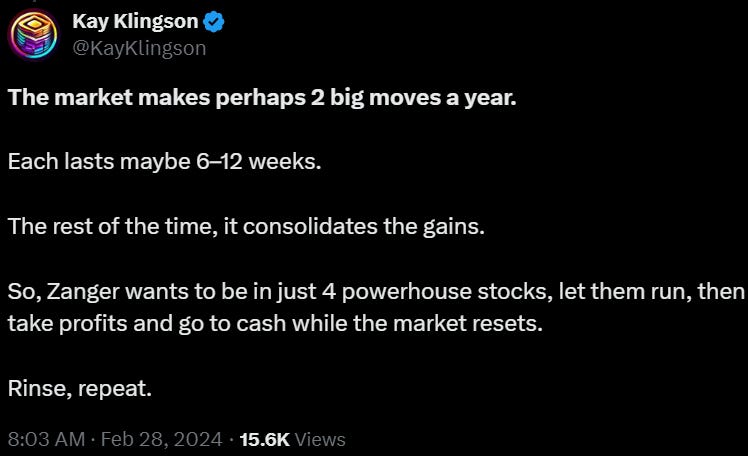
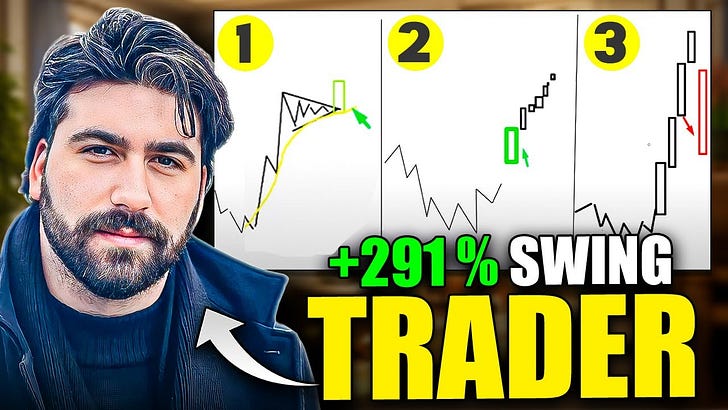






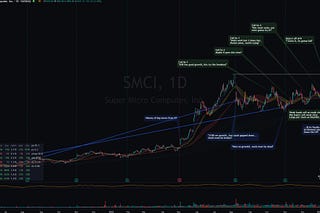
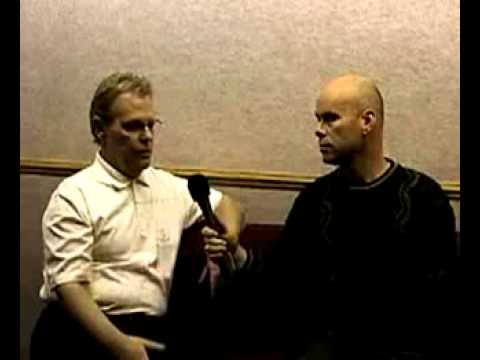

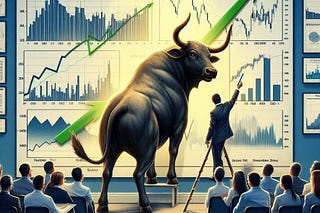
Great content as always
I loved it. It was very inspirational.